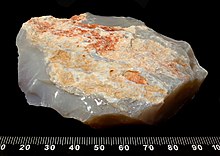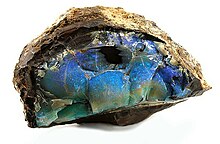



Opalescenceorplay of color is the optical phenomenon displayed by the mineraloid gemstone opal,[1]ahydrated silicon dioxide.[2]
Each of the three notable types of opal – precious, common, and fire[3] – display different optical effects; therefore, the intended meaning varies depending on context.
The optical effects seen in various types of opal are a result of refraction (precious and fire) or reflection (common) due to the layering, spacing, and size of the myriad microscopic silicon dioxide spheres and included water (or air) in its physical structure.[2][3] When the size and spacing of the silica spheres are relatively small, refracted blue-green colors are prevalent; when relatively larger, refracted yellow-orange-red colors are seen; and when larger yet, reflection yields a milky-hazy sheen.[2][6]

In a physical sense, some cases of opalescence could be related to a type of dichroism seen in highly dispersed systems with little opacity. Due to Rayleigh scattering, a transparent material appears yellowish-red in transmitted white light and blue in the scattered light perpendicular to the transmitted light.[7] The phenomenon illustrated in the bottom photo is an example of the Tyndall effect.